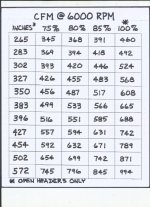toobroketoretire
Banned
Here's a carburetor sizing chart I have posted on other forums over the years that shows how many cfm your engine will consume at 75%, 80%, 85%, and 100% volumetric efficiency at 6000 rpm. Note the 100% column only reflects off road track racing engines running open headers so it does not apply to street engines running mufflers. Summit Racing recommends using 1-1/2 cfm per cubic inch for street engines and the 85% column almost exactly reflects their formula. I suggest you print this chart for future reference.
You'll notice a 350" engine only consumes a scant 517 cfm at 6000 rpm (at the 85% efficiency) which proves a 600 cfm carburetor is more than enough. In fact a 600 cfm is enough for a 383" and 396". It's not until you reach 427" that you need the larger 750 cfm. I'm running a 750 cfm vacuum secondary Holley on my beefed 454" and under full power @ 5500 rpm the secondaries are only opening about 90%.
You'll notice a 350" engine only consumes a scant 517 cfm at 6000 rpm (at the 85% efficiency) which proves a 600 cfm carburetor is more than enough. In fact a 600 cfm is enough for a 383" and 396". It's not until you reach 427" that you need the larger 750 cfm. I'm running a 750 cfm vacuum secondary Holley on my beefed 454" and under full power @ 5500 rpm the secondaries are only opening about 90%.
Attachments
Last edited:







